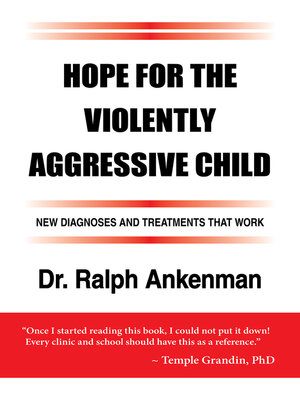Hope for the Violently Aggressive Child: New Diagnoses and Treatments that Work
ebook
By Ralph Ankenman

Sign up to save your library
With an OverDrive account, you can save your favorite libraries for at-a-glance information about availability. Find out more about OverDrive accounts.
Find this title in Libby, the library reading app by OverDrive.



Search for a digital library with this title
Title found at these libraries:
| Loading... |
The main purpose of this book is to offer effective treatment options for an urgent problem in America—children with episodes of violent aggression.
The diagnosis of bipolar disorder in children has soared. That trend has been controversial and has presented many unanswered questions, particularly when a child's problems primarily involve "violent meltdowns" rather than mania or depression. American children diagnosed with bipolar disorder in recent years should be re-evaluated for an altogether different condition that I call "adrenaline system over-reactivity." This condition is related to immaturity rather than a mental disorder, and it can be treated with medications that have fewer side effects and less intrusion on a child's mental function than the medicines prescribed for bipolar disorder.
It is fundamental to understand the relationship between aggressive behavior and immature adrenaline reactivity in order to treat the behavior effectively. Thus far, treatment strategies—including medical, behavioral, and dietary approaches—do not directly address the adrenaline-based reactivity that causes the behavior to escalate out of control.
A broader purpose of this book is to increase understanding about how adrenaline system activity impacts behavior in general. I would like to focus attention and encourage research on a question that modern medicine has not been asking: "What is the role of adrenaline stress in behavioral medicine?" This is an important direction for the future of behavioral science, particularly in children, whose physical and mental maturation is vulnerable and incomplete.
Human aggression is directly related to activation of the body's adrenaline systems. Adrenaline activity is a natural physical response that can produce threatening, attacking, agitated, or violently aggressive behavior in times of crisis or extreme danger.
Certain children have immature over-arousal of the adrenaline systems. They experience surges of adrenaline even when they are not in life-threatening situations. When this happens, their bodies have intense physical changes like a pounding heart, and intense mental changes like a loss of rational control. These changes play a major role in the intensity and momentum of their episodes. Adrenaline over-arousal can cause behavior so extreme that it can be mistaken for symptoms of a mental disorder, yet the role of the adrenaline systems is not considered when parents seek professional help.
I authored this book primarily as a description of my own 30+ years of clinical experience treating patients with aggressive and violent behavior. When I use the term "we," I am referencing my collaboration with pediatrician Dr. Edward Cutler. In recent years, we have shared information, especially about the use of adrenaline-acting medicines for treatment of aggression. We have seen many patients mature to the point that they no longer needed medication.
To date, there are no studies published that would make this treatment approach more widely available. It is my hope that this book will bring relief to those with behavior problems caused by adrenaline over-arousal and provide new options for parents and physicians attempting to care for children with intractable episodes of violent aggression. If some clinicians learn the effectiveness of adrenaline-acting medicines, researchers may conduct the studies necessary for their use to become more accepted.
Treatment of childhood aggression in America can be revolutionized if adrenaline system over-arousal becomes a standard consideration. Many children could have more effective, less expensive, and possibly curative treatment...






